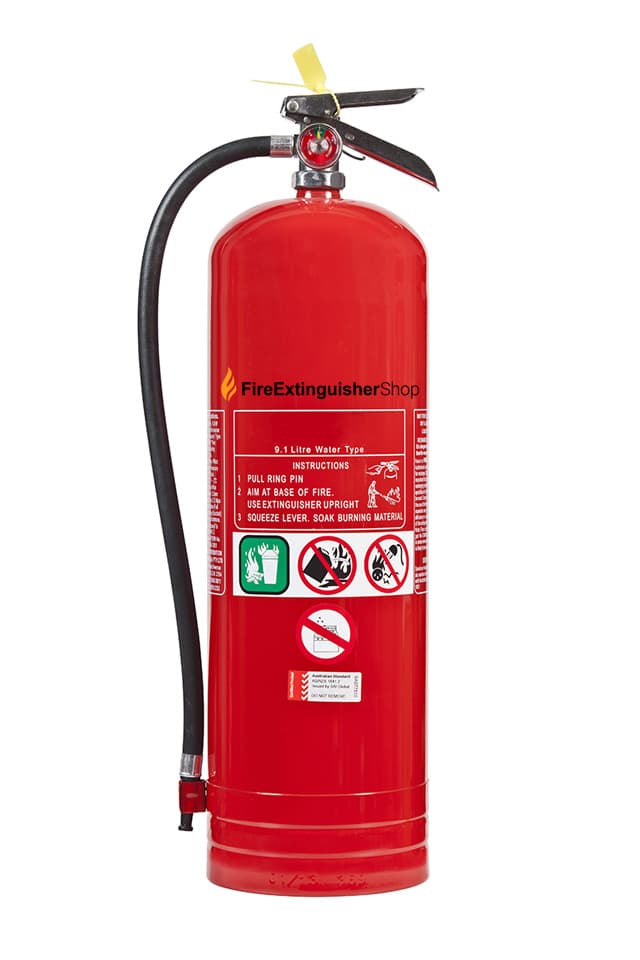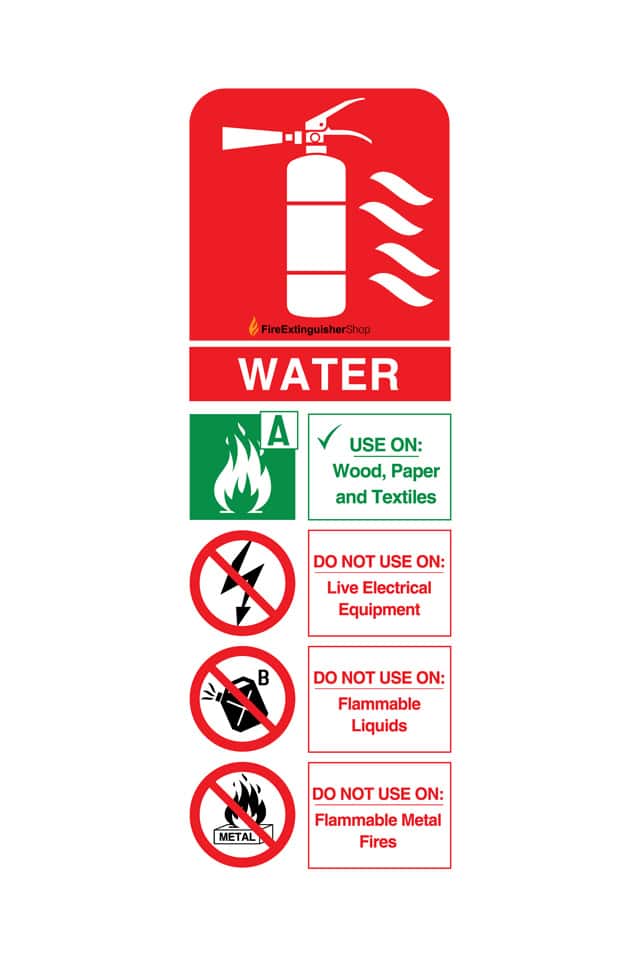LOWEST PRICE GUARANTEE if you find a lower price we'll beat it by 10%*
QUALITY GUARANTEE Products are certified to Australian Standards
FAST DELIVERY Australia wide
9 Litre Water Fire Extinguisher
$200.00 $118.00
In stock.
9 Litre Water Fire Extinguisher
Water and Foam extinguishers are a low cost effective method to combat Class B fires. Both water and foam fire extinguishers are effective by reducing the temperature of the burning fuel so it is below its ignition point. They can also be used for Class A fires which include wood, plastic, textiles, and paper.
Water fire extinguishers should never be used on fires that involve live electrical equipment.
Recently manufactured stock. Approx. 1 to 3 months.
$200.00 $118.00
Overview
9 Litre Water Fire Extinguisher
Water fire extinguishers are a low cost effective method to combat Class A fires which involve wood, plastic, textiles, and paper. Water fire extinguishers are effective by reducing the temperature of the burning fuel so it is below its ignition point.
Water fire extinguishers should never be used on fires that involve live electrical equipment.
Fast & free delivery
- Over $500 to Sydney, Melbourne & Brisbane
Delivery costs are shown at the shopping cart page and the checkout.
Features
The features of our 9 Litre Water Fire Extinguisher includes:
- Certified and Approved to Australian Standards
- Brand New
- 12 Month Warranty
**Does not include a valve for you to refill yourself. Must be refilled at an authorised facility.
Includes
Buy our 9 Litre Water Fire Extinguisher and receive:
- 1 x 9 Litre Water Fire Extinguisher
- 1 x Wall Bracket
- 1 x Maintenance Test Tag
Technical info
Certified & Approved to AS/NZS 1841.5
| Extinguisher Type | 9 Litres Water with Air |
| Agent Type | H20 with Corrosion Inhibiting Agent |
| Approvals | Australian Standard 1841.2 |
| Box Quantity | 1 |
| Bracket | Wall |
| Agent Capacity | 9 Litres |
| Fire Rating | 3A |
| Discharge Time | 65 seconds |
| Gross Mass | 12.5 kg |
| Extinguisher Height | 630 mm |
| Cylinder Diameter | 180 mm |
| Hose | Yes |
| Maintenance Test Tag | Yes |
| Cylinder Pressure Test | 5 Yearly |
| Operating Pressure | 690 KPA |
| Handle | Stainless Steel 316 |
| Valve | Chrome Plated Brass |
| Hose Retainer | Stainless Steel |
| Cylinder Construction | Stainless Steel |
| Cylinder Finish | UV Powder Coat Red |
Note: Extinguishers may look different to the image.
Water Fire Extinguishers
Fire extinguishers have saved countless lives and prevented property damage in homes, offices and workplaces. For protection and safety, these extinguishers are invaluable.
Water extinguishers are very common, but they can only be used on class A fires (solid flammables; for example, textile, wood, paper). You must not use water on an electrical fire as water conducts electricity and likely will harm you.
A water fire extinguisher for sale must follow Australian Standard 1841.2. This standard requires specific construction materials, design and colour coding for all extinguishers sold.
The standard includes rules for manufacturers’ compliance with the standards. For quality and long service life, a fire extinguisher price is low for the benefits gained.
Always Ready
There should be fire extinguishers where there are combustibles, and they need to be routinely maintained. Extinguishers are always active and ready for small fires. Most are pressurized cylinders with a valve, a short hose and a nozzle.
In an emergency, caution must be taken to assess the situation. You should always have an easy escape and not inhale any smoke. Attempting to put out an out-of-control fire is dangerous and futile, but for a small fire, you can stop it quickly and avoid more significant damage.
Extinguishers and Fire Class
There are five standard extinguishers available to Australians. The contents identify them: dry powder, wet chemical, carbon dioxide, vaporizing liquid, foam and water.
Fire classes are based on the materials involved. Understanding fire classes helps identify the best extinguisher for given materials.
Class A fires are of textiles, paper, wood, general rubbish and plastics. Most extinguishers are appropriate for this class, including water extinguishers, except ones using carbon dioxide.
Class B fires involve combustible liquids like alcohol, paint, tar, oil, petrol, kerosene, wax, grease and cleaning spirits. Water is dangerous to use on this fire class as the water splatters and sends burning liquid about. Powder extinguishers are best, and foam works well too.
Class C fires involve flammable gases like liquefied petroleum gas, liquefied natural gas, acetylene, propane and butane. Only dry powder extinguishers can be used, and the gas supply must be shut down.
Class F fires are often started in kitchens involving cooking oils, lard or butter spilling over. Here again, water cannot be used as it will splatter burning droplets about and likely on yourself. You should use a wet chemical extinguisher.
As you can see, water extinguishers are very appropriate for use on Class A fires. This is the extinguisher meant for bedrooms, living areas, storage rooms, warehouses, and so on. The lower cost is realized after a proper risk assessment identifies areas that should have other types of extinguishers on hand.
Colour Codes
When doing your risk assessment, keep in mind the official Australian colour codes for extinguishers. The colour codes are a band around the cylinder:
– Water – All Red (No Band)
– Foam – Blue
– Wet Chemical – Oatmeal
– Vaporizing – Yellow
– Powder – White
Precautions
Place and assure the proper extinguishers are near the risk area’s fuel.
Use extinguishers only if you:
– You know the extinguisher is coded for the fire’s fuel
– You can extinguish the fire quickly
– You are not putting yourself or others at risk
– Everyone in the building has evacuated
– The fire is not involved with electrical; if so, use a non-conducting agent
Water
In the 19th century, water was the first and most easily accessible agent to combat fires. As the Industrial Revolution began, homes and factories started making or using chemicals and new materials, and using water became a problem.
By the 1890s, Australia was electrifying communities, first with street lighting then homes. Factories started using electric motors and lighting earlier, so by the 1880s, fire engineers began developing technologies and training to put out electrical fires safely – they learned the hard way. The engineers continued development for the new chemicals and materials.
Firefighters, as they arrive, locate and shut off the electrical circuits and natural gas first, or they enter with the correct extinguisher, depending on how involved the fire is. In business, it is valuable to have employees well trained in using extinguishers. In the home, families need the training as well.
How Water Extinguishers Work
These original extinguishers used clear water that was pressurized with air. When you activate the valve, the water streams out through the nozzle. This is the basic configuration to this day. Modern extinguishers will likely have minor additives to increase effectiveness and protect from rust.
It cannot be overstated that water is hazardous when used against a grease fire, but water is very effective against Class A fires (wood, textiles, paper). Few people know that magnesium burns, and if water is used, a chemical reaction occurs, creating hydrogen gas producing an explosion-like reaction.
Buy Fire Extinguishers
Water is an excellent way to extinguish a Class A fire when used correctly. A quality and durable water extinguisher for sale go for about $130 -$160. A fire extinguisher price is well worth it for the knowledge of your having a safer home or workplace. The best extinguishers have longer service lives, can be tested by a fire protection professional, and are very unlikely to fail when needed.
Water Extinguishers Maintenance and Storage
Water extinguishers require regular maintenance checks and monthly inspections like all other fire-extinguishers.
- The pressure gauge should be checked to ensure that it is in the green zone and there are no leaks.
- The nozzle should be cleared of any obstruction.
- The extinguisher should be stored in a cool, dry place where it will not freeze in winter.
How Can You Identify Water Fire Extinguisher
Check for a red cylinder with a red band and “WATER” in white letters. It will have a hose. Moreover, it has a capacity of 9 litres with instructions to use.
Why Should You Buy Water Extinguishers
- To be prepared to put out Class A fires
- They’re an affordable way to prepare for fire calamities
- They’re environmentally friendly
- To be able to save your property from severe damage during a fire outbreak
- To be able to put Class A fires under control and prevent from further spreading
Pros of Water Extinguishers
- They are easy to use
- They work on Class A fires
- Water is a natural resource
- They are cost effective as fire extinguisher price costs around $120-$150.
Cons of Water Extinguishers
- They can only be used on Class A fires
- They can spread the fire or worsen the conditions if used incorrectly on other types of fires such as Class B or Class C fires respectively.
Conclusion
A water extinguisher is an excellent option for those looking to minimize the risk of damage from fires. By using this type of extinguishing agent, you can limit potential structural and property damages caused by fires. Since there are no hazardous chemicals in use with these fire extinguishers, it’s safe to buy fire extinguishers for your property.
SHOP WITH CONFIDENCE
Shopping on FireExtinguisherShop.com.au is safe and secure. Guaranteed!
SAFE SHOPPING GUARANTEE
All information is encrypted and transmitted without risk using SSL protocols. We will never share your information.
NEED HELP?
Contact our sales team. Phone (02) 8073 4627 or Email [email protected]


